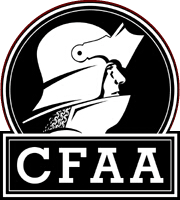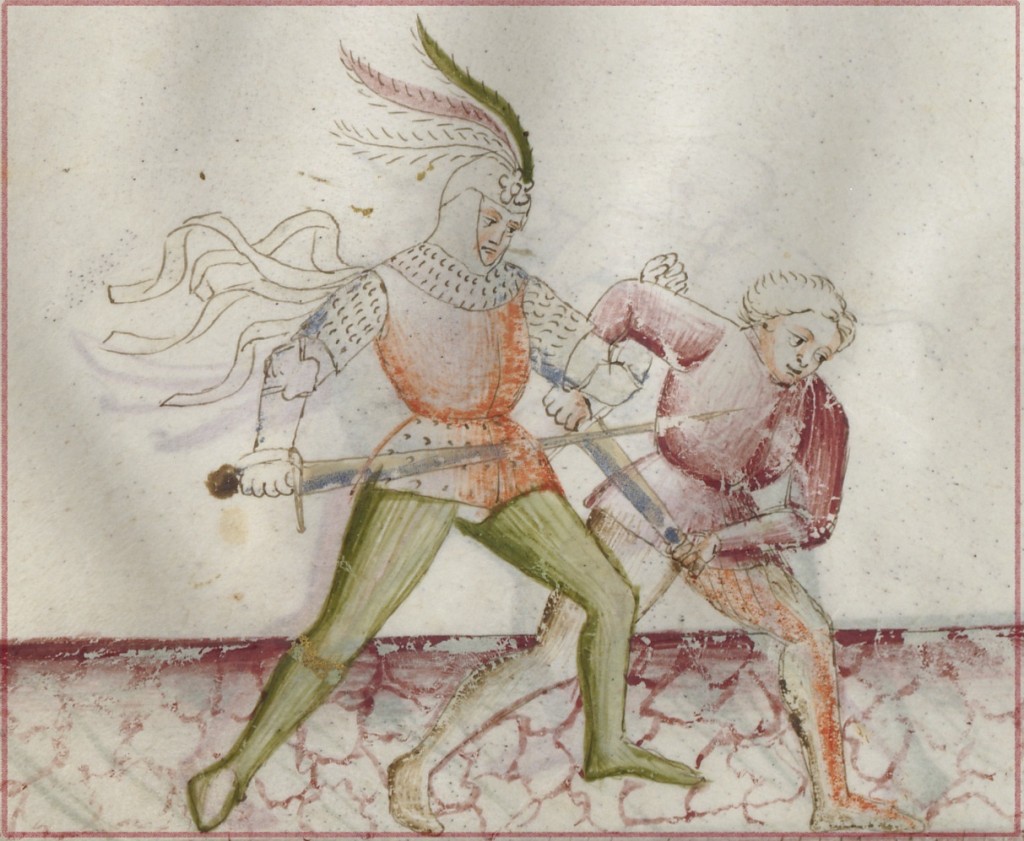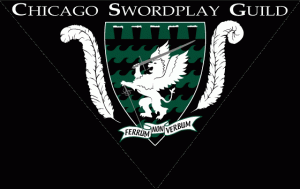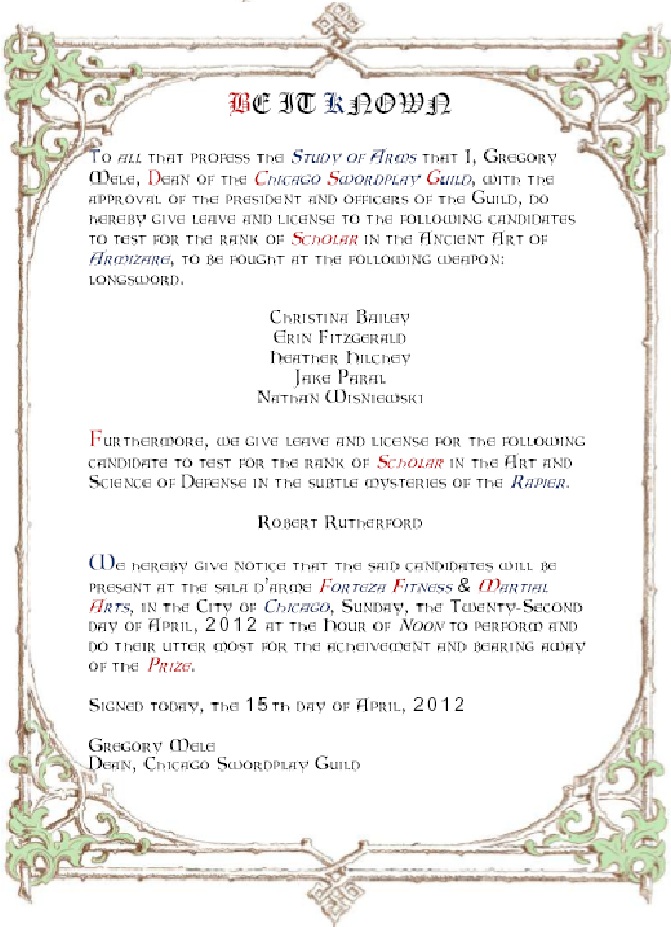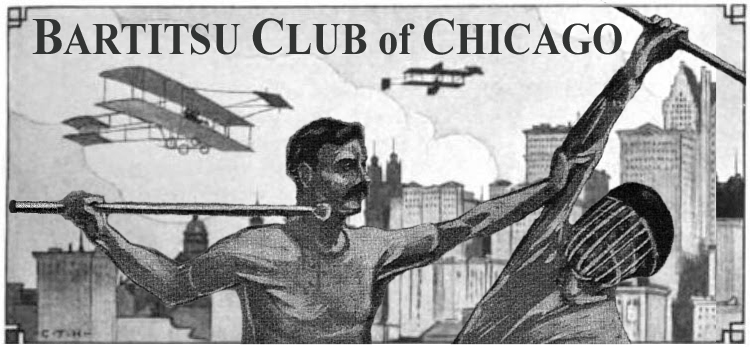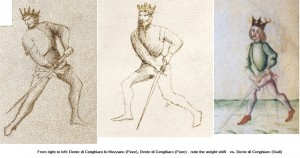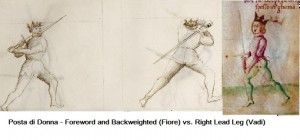(c) 2011 Ben Fisher-Bruns
Rocky Mountain Swordplay Guild
There’s a discussion on Facebook right now that was prompted by an excellent blog post from Alex Putnam-Spreier of the Northwest Academy of Arms, and I thought I should put in my two cents. I don’t consider Facebook the best format for a lengthy discussion about these things, so I’m posting it here. I’m using Tom Leoni’s translation of the Getty throughout for any quoted passages.
The discussion is around the age-old question of why Fiore and the other Italian masters don’t include ground fighting in their books. It’s a good question. Nobody really knows for sure what the answer is. Most of the technique-specific info on Italian close-quarter combat (and by that I mean grappling and dagger defense) of the middle ages and Renaissance comes from Fiore, Vadi, and Marozzo. As far as I can tell, the only places in these three masters’ books where “ground fighting” (which I’m calling any situation where one or both combatants are already off their feet and on the ground) is explicitly or implicitly addressed, are as follows:
1: The Master of Throws from Fiore’s dagger section. He’s pinning a downed opponent to the ground with his feet.
2: The part in the two-hand sword section of the Getty concerning the leg cut, where he says, “If you had fallen on the ground, striking the opponent’s leg would be fine, but not in any other circumstance, when you are fighting with a sword against a sword.” Not “close-quarters,” but it does refer to a technique on the ground.
3: Marozzo’s nineteenth presa, which is the sacrifice stomach throw (equivalent of tomoe nage). It’s a throw, but you have to put yourself on the ground in order to do it.
4: This last one is debatable, but there is also the play of the first scholar of the fourth remedy master of the dagger from the PD. Carried to its logical extreme, this play winds up with both combatants on the ground with the player’s elbow either dislocated or broken. It’s not necessarily ground fighting per se, but it could involve the scholar putting himself on the ground intentionally for purposes of harming the player, so I’m including it for completion’s sake.
And that’s pretty much it with regards to ground fighting. If I’m missing something, I have no doubt someone reading this will inform me of it. (As an aside, since I don’t have a good translation of all of Marozzo and it would take quite a while for me to read it in Italian, does anyone know of anything from the other sections that addresses this subject? I’d be curious to find out.) The point is that ground fighting does not play a significant role in the historical Italian arts as presented in these three books.
So why is that? One well-worn argument is that we’re dealing with an armed culture, and grappling on the ground with daggers in hand is seldom the wisest course of action. This is true. In German manuscripts that deal with daggers on the ground, it’s generally a situation where one combatant has pinned the other, and only then does he draw a dagger and stab the opponent.
Also, there’s the old standby of “fighting on the ground is the last thing you want to do on a medieval battlefield, because you’ll be spitted/trampled to death by your opponent’s comrades/everybody else.” This is also true. But what about unarmed ground fighting outside of a “battlefield” context? What about simple self-defense (say, a dagger assault that’s turned really ugly and wound up on the ground)? Why does that not show up?
One could use the “armed culture” argument to say that, because you must always assume the opponent is carrying a weapon on their person, you should devote the vast majority of your training to learning how to deal with an armed attack. Maybe that’s why the abrazare section is so brief in Fiore. He gives you a nice, simple, well-contained set of techniques for an unarmed grappling situation, and then moves straight on into dealing with weapons. One assumption is that, if you know your abrazare, and you can defend yourself from a man armed with a dagger using only your empty hands, you should be able to handle pretty much anything an unarmed opponent can throw at you. This idea has been raised before.
In which case, the lack of ground fighting may simply be a reflection of the lack of purely unarmed fighting to begin with. In essence, the master may be saying, “It’s more important to learn to defend yourself from weapons, so learn these grappling moves and don’t worry about fighting on the ground too much. As long as you stay on your feet, you’ll be safe.”
I seriously doubt that that’s the answer to the initial question. That may be part of it, but if it is, it ain’t the whole story. Mr. Putnam-Spreier brought up a good point when he referenced Fiore’s comment about throwing the opponent without putting yourself in danger. In the opinion of Mr. Putnam-Spreier (and others), this means being able to throw the opponent while remaining standing, first and foremost. I’m guessing that any self-defense teacher worth their salt will tell you that it’s better to end the fight quickly and stay on your feet so you can get the hell out of Dodge as soon as the opponent goes down.
Fiore seems to have been no different. In his explanation of the crown/garter iconography and the organization of the treatise, he says that “Few plays, however, can go beyond the Third Master, after which lies danger.” The most common interpretation of this sentence that I’ve encountered is that the fight should not go beyond two counters, because after that the sequence of events becomes too difficult to predict. Ideally, the fight should last only as long as it takes to perform one action. This is a very pragmatic way of approaching a fight. It’s echoed by modern authors such as Steve Pearlman, who says that one should train to end the fight as quickly as possible, because there is no good reason not to.
In weapon sparring, we’ve all seen how ground fighting really tends to occur either after both people have failed at zogho largo, or one person has decided to close to zogho stretto, and neither combatant has been able to throw their opponent cleanly (i.e., without falling). In other words, ground fighting only occurs in weapon sparring after both people have fucked up. Interestingly, this echoes George Silver’s opinion:
“…when 2 men shall meet that both have the perfection of their weapons, against the best no hurt can be done, otherwise if by any device one should be able to hurt the other, then there were no perfection in the use of weapons, this perfection of fight being observed, prevents both close fight, & all manner of closes, grips & wrestling & all manner of such devices whatsoever.”
In other words, if you do everything right, there should be no reason to even come to grips, much less wrestle on the ground (not that Silver doesn’t use grips and throws; he certainly does. But the point still stands).
This leads us to another possibility: perhaps ground fighting was not addressed, not because it was merely considered unimportant, but because students were actively discouraged from even engaging in it. It was considered either too dangerous, or indicative of poor overall weapon skill.
However. Everyone knows that, if you get in enough fights, eventually you’re gonna wind up on the ground. Fiore knew this damn well; he says that cutting below the knee is fine if you wind up on the ground. Of course, he may have made that remark only because he was talking specifically of the leg cut, and wanted to make himself clear about not cutting below the opponent’s knees. Again, perhaps he would have discouraged his students from even considering going to the ground, and therefore not have addressed what to do when you get there. Perhaps the emphasis was placed on staying on your feet at all costs, and the leg cut remark was only to clarify his earlier statement about not cutting below the knee.
Or perhaps not. Perhaps the Italians had an entire system of ground fighting that they simply didn’t explain in detail. Maybe it looked something like the uUnterhalten techniques of the Kunst des Fechtens. Mr. Siggs and others have addressed the topic of “Fiore ground fighting,” by which they mean the application of Fiore’s principles to a fight on the ground. This is a perfectly valid extrapolation, and I’ll get back to it in a second.
First I want to bring up Pietro Monte. (God, do we need a good translation of his books. I read something on the web about some folks attempting a non-academic translation of either the Collectanea or De Dignoscendis Hominibus or both, which is fine with me, because I want to read the fuckin’ things and it would take a while to re-learn all my Latin well enough and I’m not gettin’ any younger. I also heard a rumor that Dr. Forgeng was working on it, but I have no idea if that’s true.)
Monte was a Spanish condottiere who was working in Italy and is associated with the court of Urbino in the late 15th and early 16th centuries. In addition to writing on athletics and martial arts, he’s supposed to have written a conceptual refutation of Aristotle that predates Galileo by a hundred years. Which has nothing to do with ground fighting, but is pretty damn cool. Anyway…
Monte wrote his opinions on different types of sport wrestling that were practiced in various countries during his time. While in this case he was writing about combat sports and Fiore was writing about actual combat, the two disciplines overlap in many cultures and we can reasonably assume that someone studying “combative abrazare” would probably have been familiar with aspects of the “sport” variety. At one point Monte says that he prefers a style of wrestling where the goal is to throw the opponent to the ground and grabbing the legs is not permitted. He acknowledges the effectiveness of grabbing the legs in an actual fight, but prefers only upper-body holds for sport.
Moreover, he has a very low opinion of the Germans and their style of ground-wrestling. He seems to be of the opinion that wrestling on the ground, especially stripped to one’s underwear, is 1) not a particularly practical self-defense art with little utility for war, 2) is a somewhat barbaric activity. [Makes one wonder what he would think of the popularity today of no-gi BJJ competitions.] In this, he is not alone among historical writers. Many of the English self-defense authors (Donald Walker, for example) had little use for ground wrestling, describing it as ungentlemanly, or simply unmanly. It’s really no wonder they thought this way about ground wrestling: consider that some of the best ground wrestlers of the nineteenth century were Lancashire coal miners and American carnival strongmen. It was a low-class activity, whereas pugilism, or “fist-fencing”, was the fighting art of gentlemen.
Monte’s opinion seems to indicate that similar attitudes have been held (at least by some people) for centuries. Now, whether his opinion holds true for the condottieri in general, or for the military or social elite of the Renaissance Mediterranean world, or whatever, is not knowable without a lot more documentation. But it is definitely the opinion of at least one prominent soldier of early-Renaissance Italy.
Taken at face value, what might Monte’s opinions mean when looking at Fiore? Well, Fiore shows no ground fighting in his abrazare section. Moreover, most of the throws involve only upper-body holds, with the legs used only as a fulcrum. This might make sense for a person who had been practicing (perhaps since childhood) a type of sport wrestling similar to what Monte describes. Of course, Fiore may have done no such thing.
(A few interesting points: in Fiore, there is no such thing as a double-leg takedown. Also, at no point does he use both hands to grab an opponent’s leg. Either he’s using one hand to control the opponent’s arms or upper body, or he has a weapon in one hand while grabbing the leg and is using it to control the opponent’s weapon.)
One question is: does a lack of ground wrestling for sport translate into a lack of ground fighting for actual combat within the same culture? It seems like it might have in southern England (catch wrestling being a Lancashire specialty, and therefore more popular in the north). And whether that’s a causal relationship, and in which direction, is an open question. But there certainly are cultures outside of Europe where ground fighting does not play a large role in either wrestling or martial arts. The Chinese have a cultural distaste for ground fighting (heck, the Chinese have a cultural distaste for physical contact, period; hence the preponderance of long weapons and long-range striking techniques in a lot of Chinese martial arts). Dr. Yang Jwing-Ming has said as much in his books on chin na and white crane gungfu. I found an old gungfu book that Pete Kautz once wrote a review of. It was written in the ’30s, and according to Pete the ground control techniques all seemed to be borrowed from jujitsu after contact with the Japanese. Also, in the chin na book I just mentioned, Dr. Yang states that it is “unpredictable and dangerous to tangle with an opponent on the ground.” Therefore, the ground fighting sections of that book borrow techniques from jujitsu and aikido, and are performed in the photographs by Japanese martial artists. (However, the authors are careful to point out that the principles of chin na still apply to the ground holds. More on this later.)
There are people here who will not appreciate the comparison with Chinese martial arts. The point is that there are cultures with long-standing martial arts traditions that use no ground fighting. Competitive shuai-jiao (Chinese wrestling) is standing-only, and its combative equivalents are standing-only. This is one of the most often-criticized flaws in CMA.
It is possible that this is also an inherent flaw in historical Italian martial arts. Maybe they just didn’t engage in ground fighting, and therefore weren’t very good at it. There is certainly not much direct evidence of it in the manuscripts. However, that does not mean that the principles expressed by, say, Fiore, do not still apply in a ground fight. This is because Fiore’s armizare is a good art, not a crap art. If it were a crap art, you would expect its foundational principles to break down when applied outside of their intended context. Greg has outlined three principles that seem to apply throughout Fiore’s art:
1: Break from above, strike from below.
2: Break from below, strike from above.
3: Seize the center.
These can all apply to ground fighting. Similarly, principles from an art that deals extensively with ground fighting, like catch wrestling, can still apply to (for example) a medieval judicial duel. One fundamental principal of catch wrestling is to always keep the opponent’s body in an unnatural position, and to always keep him uncomfortable. This is good advice, regardless of whether the fight is standing or on the ground.
Will Fiore’s principles, applied to a ground fight, look exactly the same as they would in a “standard,” stand-up fight? Of course not. Will catch wrestling principles, applied to a duel, look the same as they would in a wrestling match? Hell no. But the principles all hold true. It’s entirely possible that Fiore, if taken to the ground by a wrestler and not having a weapon to hand, would still hand them their ass in a matter of seconds. He comes across as such a devious bastard in his books that I would consider that a pretty reasonable outcome.
No one art does absolutely everything well. Most arts do at least a few things well. If they’re good arts, their principles can be adapted to situations they were not explicitly designed for. None of this means that the Italians either did or did not know how to fight on the ground. Indeed, this is really just a set of speculations, more than a working thesis. But when there is a clear preference for or against certain kinds of combat in a given art, a little speculation as to why can yield insights, if not answers.
